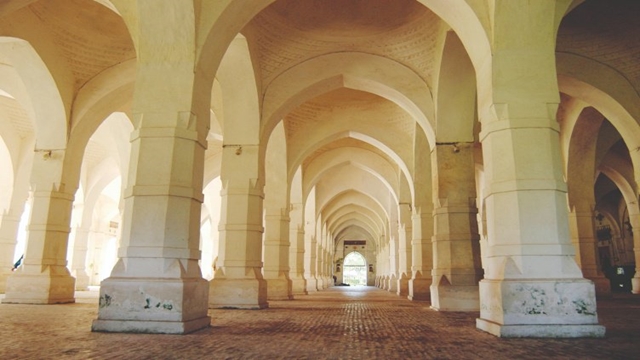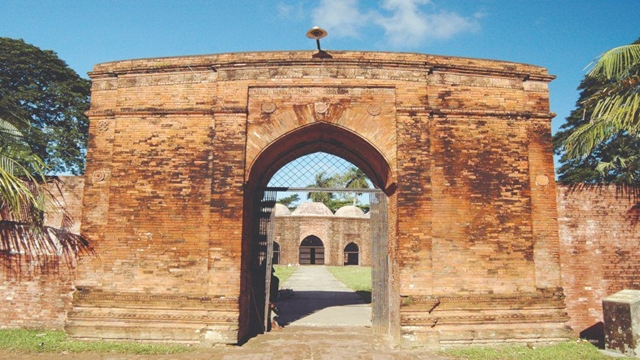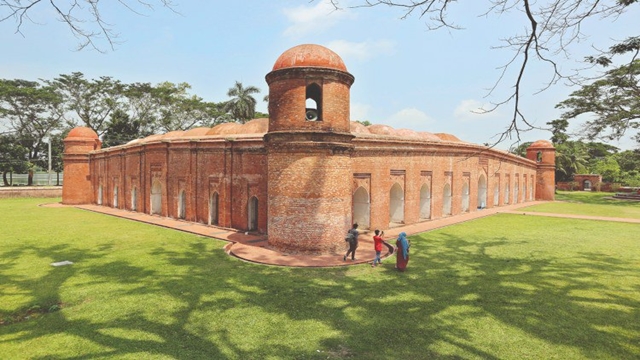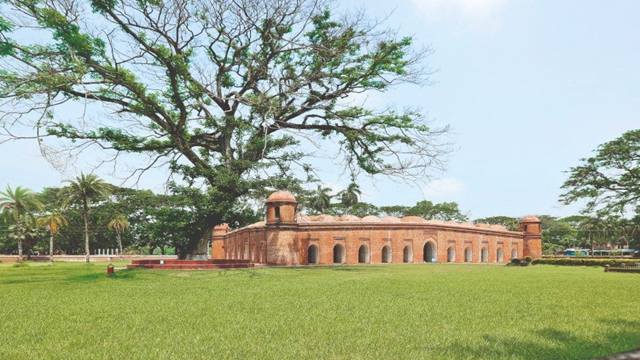FT Online
Published:2019-06-23 21:43:40 BdST
Visiting this famous landmark at BagherhatThe mosque of the sixty domes
The Shait Gambuj mosque is the most magnificent as wellas the largest enclosed type mosque in Bengal. Although the date of its erection is not known, it is considered to be the Great Congregational Mosque of Khan Jahan Ali built during his lifetime in the early 15th century at Bagerhat.
The name ‘Shait Gombuj’ or ‘sixty domes’ is misleading: it has as many as 81 domes: 70circular domes upon the prayer hall, seven chauchala domes upon the central aisle and four domes upon the corner towers.

The mosque has an oblong shaped prayer hall measuring externally 48.95 m by 32.25 m with a 2.43 m thick surrounding brick wall. The hall is internally divided into seven bays and eleven aisles.The central aisle is wider and higher than the side aisles. The eastern wall consists of a row of eleven pointed-arch openings while each of the side walls has seven. The central opening in each side is larger than others, which was used as the entrance way and the rest six openings on each side were probably closed with a perforated brick. In the northern wall, an evidence of such perforated brick jail is still in situ. Only the central mihrab niche has a multifoil arch and the rest have two centered pointed-arches supported on two sides by pilasters. The right aisle of the central mihrab niche has an off centered arched doorway instead of a mihrab niche. The provision of an entrance, adjacent to the central mihrab niche in the kibla wall, indicates that the Khan Jahan Ali's residence was located to the west or north-west side ofthe mosque.

The freestanding 60 pillars (55 stone and five brick pillars) support the whole roof. It can be possiblethat the name of the mosque derived not from the number of domes (77), but from the number of the supporting pillars(60). Hence it may be stated that the original name of this mosque was Shait (60)Khamba (local dialect for pillar) mosque. In course of time, this Khamba(pillar) might have been confused with Gambuj (dome). The Chauchala vault of this mosque is believed to be the earliest example of the reproduction of the rural bamboo-roof into a masonry vaulted roof. The parallel bamboo rafters and cross bars of the hut are also imitated from within. The top part of the central arched opening had a triangular pediment, from which the cornice slopes down towards the corner. The cornices on the other sides are typically curved.
Recently the interior and the exterior of the mosque have been totally altered. The triangular pediment placed above the central entrance has been removed; the floor and the freestanding stone pillars have been covered with plaster on brick by the Directorate of Archaeological Bangladesh, the official custodian of our cultural properties and world heritage. The famous or remarkable freestanding 60 stone pillars are now unrecognizable, and the shafts are no longer slender. The bulkier new pillars make the interior space appear more congested.

The exterior of the mosque is without plaster and ornamentation. All the entrances are recessed with rectangular frame and have raised brick mouldings with a geometrical terracotta motif. The eleven frontal doorways have decorated terracotta rosettes in the spandrel, the central opening has two more rosettes on the either side of the spandrel.
Unauthorized use or reproduction of The Finance Today content for commercial purposes is strictly prohibited.


